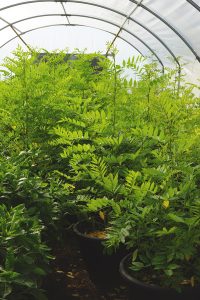
Making an Indigo Fermentation Vat
| 1st May 2013Last year’s woad is now in flower and looking lovely and my bees are

Woad is now in flower and looking lovely
really enjoying them. But his year’s woad plants are still too small to cut and I would think it will be a few more weeks yet before I can make my woad pigment.
In the meantime – now the weather is finally warming up (a little!)
I have been busy recharging my large natural fermentation vat which holds 220 litres. I have also been setting up another 4 smaller vats (60 litres) ready for my workshops.
I keep/ferment my indigo vats in a greenhouse that is away from the house as it does have a very distinct odour! Personally, I don’t mind it – but some people find it unpleasant.
I love indigo! It is the only fast natural blue dye. It does not require a mordant.
There are many ways to make an indigo fermentation vat but the following is the one I use most of the time.
- 4oz ground indigo powder
- 2 oz. madder powder
- 2oz wheat bran
- 12oz soda ash (washing soda)
- A container to hold about 3 gallons
This is enough to make a small vat of about 3 gallons. To make larger vats simply multiply the quantities in proportion until you have enough to fill your vat size.
To make the small vat ¾ fill a 3 gallon bucket with warm (not hot) water.
Wearing a dust mask and gloves first weigh out your ingredients separately. Dissolve the ground indigo in enough warm water to make a paste. If you don’t make a paste the indigo will float on top of the vat.
Add the bran, madder, and soda ash to your vat and stir. Gently add the indigo paste and briefly stir again without introducing oxygen to the vat.

My digital reader
I try to maintain a temperature of about 100 degrees Fahrenheit. I use an aquarium heater in each of my vats and find this works very well.
Stir carefully once or twice a day.
The vat should be alkaline with a reading of pH10.
Keep the vat covered. If you leave more than 2 inches of air at the top of the vat it will not reduce properly.
Depending on the temperature the vat can take between 7 – 10 days before it is ready for dyeing.

When the vat is ready for dyeing it will develop a coppery film on the top of the vat and the liquid will appear green (not blue)
My large vat is now entering its 5th year and with the correct conditions should last indefinitely. When it becomes “exhausted” I simply recharge it with the correct proportions of the required ingredients and leave it for a few days and then it’s good to go again!
A natural fermentation vat is an ancient tradition and cannot be rushed.
 |
 |
 |
Our indigo plants grown in the polytunnel ready to harvest in September.


